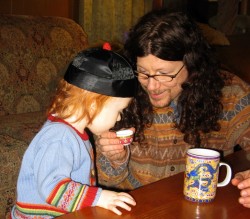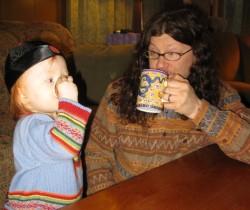On The Subject of Tea: Puer
Although we do drink a fair amount of coffee in the morning at our house, the signature beverage here is actually tea.
I know this to be true because we have more varieties of tea in our cupboard than we do coffee.
And though we do have many types of tea which that we enjoy, the tea most often brewed and consumed–on at least a once daily basis, is a Chinese fermented black tea known as shou puer. (There is also a less oxidized variety that can be classified as a green tea known as sheng puer, but I prefer the black tea, so when I talk about puer, I mean shou puer and I am just too lazy to type the entire thing.)
Puer, also know as pu-ehr comes from a large-leaf variety of Camillia sinensis that is grown in Yunnan province, China, and is famous throughout the country for its earthy flavor and aroma and its reputed restorative, healing and digestive properties.
I am told that it is often the chosen beverage for a dim sum luncheon, where its stomach-calming properties make it a perfect accompaniment to the rich meat-stuffed steamed dumplings, pan-fried turnip cakes and crispy, deep-fried taro fritters that are consumed in great quantities. I like to drink it by itself–just as a sort of pick-me-up for long evenings spent sewing, writing, playing with Kat or cooking, and Zak finds it invaluable as an aid to late-night guitar playing.
I have seen it written that puer has the highest amount of caffeine in a Chinese tea, but I must say that I have never had trouble sleeping even on nights when I have stayed up late quilting and drinking cup after cup of puer like a madwoman. If I tried that trick with coffee, I would be up for the next three days, my eyes bugged out with fingers twitching like an addict coming off of crystal meth. Zak doesn’t seem to have that trouble, either–he can sleep just fine after drinking puer by the potful and playing guitar while Kat safely slumbers upstairs.
The truth is, neither of us drink puer because it keeps us awake–we drink it because it tastes good.
The lady who owns our Chinese market in town says we are the only Anglos who buy puer, or who even know what it is. Most people, she says, when they taste it curl their lips and say it tastes like dirt.
Which, in a way, it does. Poetically speaking, it tastes the way the sun-warmed rich soil of the forest smells–it is like drinking the lifeblood of Mother Earth herself. It is rich and complex–and has a rich reddish-amber-brown color. And while I guess some people find that distasteful–I find it to be intoxicating. I love the flavor of it–it is seductive, and after drinking it often for a long time, I find it hard to be happy with other types of tea, even my long time favorites, pouchong and lapsang souchong.
Some people may be put off by the cost of puer tea–because it is fermented and aged, the older teas are more expensive. It is fairly rare, since it comes only from old wild tea trees in the mountains of Yunnan province.
But what is interesting about puer is that you can get a huge number of steepings from a single pot-sized portion of tea leaves. We’ve steeped one batch of really nice puer leaves about six or seven times, and the flavor only gets nicer as we go along. It isn’t odd to get multiple steepings from one pot of good Chinese tea leaves, but puer just seems to be the workhorse of the tea leaf world–it’s just keeps going and going like the Energizer Bunny. It is just a highly forgiving type of tea–many tea leaves require exact temperatures and brewing times to the point that it seems like they are harder to make than meringue on a humid day, but puer is really hard to screw up.
Here is a good overview of how to brew puer tea, along with information on the history, culture and health benefits of puer tea.
We have bought good puer from several sources, but our favorites have been from Holy Mountain Trading Company, Special Teas,. and the Tao of Tea.
You can get it in several forms–loose leaf, which is the type we prefer, in compressed bricks, which is easier to store, and stuffed into dried tangerine skins, which scents the leaves with a lovely floral citrus note that floats as light as a dancing feather over the darker, earthy notes of the tea’s natural flavor.
So there you are–in a household of tea drinkers, this is our favorite, and can be considered the house beverage, since we drink it easily two or three times a day.
Even if it does taste a bit like dirt.
(And yes, Kat loves it, too.)
12 Comments
RSS feed for comments on this post.
Sorry, the comment form is closed at this time.
Powered by WordPress. Graphics by Zak Kramer.
Design update by Daniel Trout.
Entries and comments feeds.






I love Kat’s openness to such a diversity of tastes!
There is a Chinese teahouse that opened in my Denver neighborhood recently (pictures here)that has a great variety of pu’er teas (and every other kind you can think of). It’s a nice place to experiment with different kinds before committing to a batch to take home.
Comment by Kitt — January 27, 2009 #
The Herald Tribune recently had a big article about the collapse of the Pu’er market in China. Think the great Tulip collapse in Holland in the 1600’s. Or the housing bubble collapse here. People were buying futures on speculation, and farmers were going into debt to buy more and more plants and product thinking prices could never go down, and prices collapsed by a power of ten. Now many farmers are ruined.
I’ve never tried it myself (more of an oolong gal), but I thought the article was fascinating.
http://www.nytimes.com/2009/01/17/world/asia/17tea.html?_r=1&hp
Comment by Diane — January 27, 2009 #
My ex-husband loved Pu’er. I’m a lapsang gal myself. We used to joke that he drank the forest floor, and I drank it after the forest fire.
Comment by Seattlejo — January 27, 2009 #
I have always like Lapsang sushong (sp?) because it has an earthy smoky flavor to it. As for the afternoon caffeine fix, I could not function without it. I turn my electric kettle on every afternoon as soon as I get home. Nothing like tea and scones after a day at school.
Comment by artcargirl — January 27, 2009 #
I am a girl who apparently loves the taste of dirt, wood and smoke as mushrooms, truffles, earthy stinky cheese, bourbon, lapsang, scotch, etc.
I do have puer in my cupboard and it makes a mighty nice marinade/brine as well. Have done a whole chicken cooked in puer…very nice.
Comment by jo — January 27, 2009 #
There is a sweet little teahouse in Columbus too–do you remember it artcargirl? I love trying new teas.
Diane–I should have mentioned that article–thanks for posting a link!
Artcargirl–I adore lapsang souchong–it used to be my favorite until I had good puer. Now, we do drink both of them here, but puer more often.
Seattlejo–I love that way of looking at your respective tastes in tea! Hilarious!
Jo–I like the idea of puer simmered chicken.
I must try it sometime.
Comment by Barbara — January 28, 2009 #
Pu-er is my favourite tea too… I also like the lighter way of drinking it, which is to mix Pu-er tea leaves with dried chrysanthemum flower petals.
Comment by HP — January 28, 2009 #
I also adore puer (thanks, Barbara). I tried puer tuocha, which are compressed into bowl-shapes, from the same company whose puer I regularly drink. They had little flavor, even after long steeping and multiple steepings, ‘washing’ them before brewing, and varying my water temperature up to boiling. That made me sad as tuocha are such cute little things.
Comment by Heather — January 28, 2009 #
Kitt: Capital Tea, which is about 4 blocks west of Seven Cups (on Broadway in Antique Alley) also sells two varieties of Puer that are quite excellent and won’t drain your wallet like the prices at Seven Cups (which are close to extortion–14 bucks for a pot of tea, Seriously?). Capital Tea also sells a fine selection of about a dozen green teas and some really good Oolongs. The Japanese greens are my favorites.
Comment by Roxanne — January 28, 2009 #
Thanks, Roxanne. I don’t think I’ve paid more than $5 for a pot of tea at Seven Cups! And I’m usually there for a while, so I get a few refills, too. I do like Capital Tea, too, though. They use eggs boiled in a smoky Lapsang Souchong to make stellar egg-salad sandwiches.
Barbara, that’s something you might try. Tea eggs for egg salad. Yum.
Comment by Kitt — January 29, 2009 #
I love love love love puer 🙂 And have a bad habit of ordering from Seven Cup’s online shop like an addict… 😉
That said – have you ever tried mixing puer with lapsang souchong, half and half? Well worth it as the smoke and the woods tastes blend quite well. 🙂
Comment by Bastlynn — January 29, 2009 #
Seven Cups’s prices at their online shop are not horrifically far off given the quality of the teas they deal in. But the price for tea brewed in a tea house (like coffee brewed in a coffee house) is almost guaranteed to be excessive.
Comment by Bastlynn — January 29, 2009 #